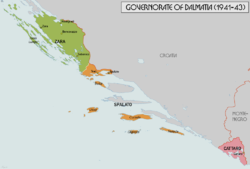Province of Spalato
The Italian Province of Spalato (1941-1943) was an administrative section of the "Governorate of Dalmatia", created during World War II by the Italian government with Regio Decreto Legge of May 18, 1941.[1]
Characteristics
The Province of Spalato was part of the Italian Governorate of Dalmatia and had an area of 975 km² with a population of 128,400 inhabitants. It was included the two main cities of Spalato (Split) and Trau (Trogir) and their hinterland, extending north to Sebenico (Šibenik). Additionally there were the islands of Lissa, Curzola, Lagosta, Cazza, Pelagosa (these last 3 removed from the "Italian Province of Zara") and Meleda.
The province bordered only the Independent State of Croatia. The "Capoluogo" (administrative center) was Spalato, where there was the "Tribunal" and was edited the Italian newspaper "San Marco". There was even the football team AC Spalato, that substituted the local Hajduk ruled by Slavs.[2]
Most of the population of the newly created province was Croatian, but there was even a small -but historical- community of nearly 3,000 Dalmatian Italians (only in Spalato city they were more than 1,000 in 1940, even if greatly reduced from the first half of the XIX century when they were more than one third of the city's population [3]).
History
Italian General Vittorio Ambrosio conquered in a few days all the Dalmatian coast of Yugoslavia, and occupied in April 1941 the area of southern Dalmatia around Spalato (called officially "Split" only since 1919). [4]
The new Italian province of Spalato was created by order of Mussolini the next month, with the "May 19 Treaty between Italy and Croatia".[5] Valerio Paolo Zerbino was named "Prefect" of the Province of Spalato, serving from June 1941 to August 1943.
The governorship of the Spalato province (and all the Governorate of Dalmatia) was held by Giuseppe Bastianini until January 1943 when he was recalled to Italy to join the cabinet; his place as governor was taken by Francesco Giunta.[6]
In summer 1941 the Italian government started a policy of "Italianization" in all the Governorate of Dalmatia. New Italian schools were opened in Spalato. Administrative personnel from Italy moved to Spalato and Trau (nearly 6,700 Dalmatian Italians took refuge in Italy after the creation of Yugoslavia in 1919, and many of them were offered work if they returned to settle with their families in the Governorate of Dalmatia). Bastianini started needed public works, building hospitals, sewage systems and roads in the area.[7] Even the "Bank of Italy" opened a branch in Spalato [8]
Thousands of Jews from Croatia took refuge inside the Governorate, and many moved to the Spalato area mainly in 1942.[9]
In August 1943 the Governorate administrative personnel left Dalmatia and returned to the Italian peninsula: the area was ruled by the Italian military until mid-September 1943 when was occupied by German troops. After the disappearance of the province, all the area -that under Italian presence was spared the bloody guerrilla that happened in Ante Pavelic's Croatia- started to be involved in the massacres of the Yugoslavian civil war during WWII.
After WWII nearly all the 3000 Dalmatian Italians of Spalato were forced to emigrate from Tito's Yugoslavia, but in 2012 there were still 100 in the city.[10]
"Comuni" of the Province of Spalato
The "Comuni" (Municipalities) of the Province were 13 (2 of them, Spalato and Curzola, had a special status):
- Spalato / Split; population 46,900
- Blatta di Curzola / Blato; pop. 6,000
- Castelvecchio Inferiore o Castel Vecchio / Kaštel Stari; pop. 5,500
- Castel San Giorgio / Kaštel Sućurac; pop. 3,500
- Castel Vitturi / Kaštel Lukšić; pop. 4,000
- Comisa / Komiža; pop. 5,000
- Curzola / Korčula; pop. 10,000
- Lagosta / Lastovo; pop. 3,000
- Lissa / Vis; pop. 8,000
- Meleda / Mljet; pop. 2,000
- Solta / Šolta; pop. 2,500
- Traù / Trogir; pop. 25,000
- Vallegrande / Vela Luka; pop. 7,000
Province Of Spalato Media
Related pages
Notes
- ↑ Regio Decreto Legge del 18 maggio 1941 n. 452 (published in Italian "Gazzetta Ufficiale" I, 1941, No. 133. p. 2240 f.)
- ↑ "AC Spalato substituted the Croatian Hajduk (in Italian)" (PDF). Archived from the original (PDF) on 2012-12-04. Retrieved 2013-01-28.
- ↑ Guerrino Perselli. I Censimenti della popolazione dell'Istria, con Fiume e Trieste, e di alcune città della Dalmazia tra il 1850 e il 1936. Unione Italiana - Fiume & Università Popolare di Trieste. Trieste - Rovigno, 1993; p. 451
- ↑ Vittorio Ambrosio
- ↑ "Map of Governate of Dalmatia". Archived from the original on 2015-02-04. Retrieved 2013-01-28.
- ↑ Jozo Tomasevich, War and revolution in Yugoslavia, 1941-1945: occupation and collaboration, Stanford University Press, 2001, pp. 136-137
- ↑ "Dalmazia "Redenta" (in Italian)". Archived from the original on 2012-03-09. Retrieved 2013-01-28.
- ↑ "Fascism's European empire: Italian occupation during the Second World War", by Davide Rodogno; p. 279
- ↑ The Rescue of Jews in the Italian Zone of Occupied Croatia
- ↑ Police report 1941-1943
Bibliography
- Pavlowitch, Stevan. Hitler's new disorder: the Second World War in Yugoslavia. Columbia University Press. New York, 2008 ISBN 0231700504
- Praga, Giuseppe. Storia di Dalmazia. Dall'Oglio editore. Varese, 1981
- Rodogno, Davide. Il nuovo ordine mediterraneo. Ed. Bollati Boringhieri. Torino, 2003




